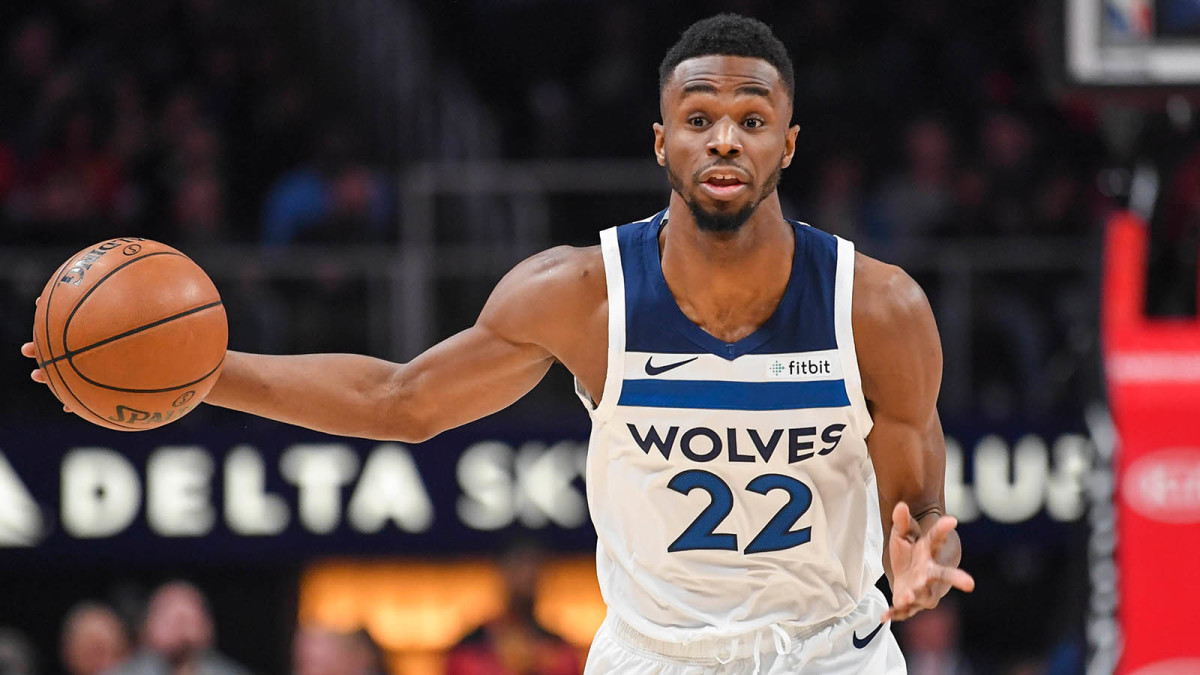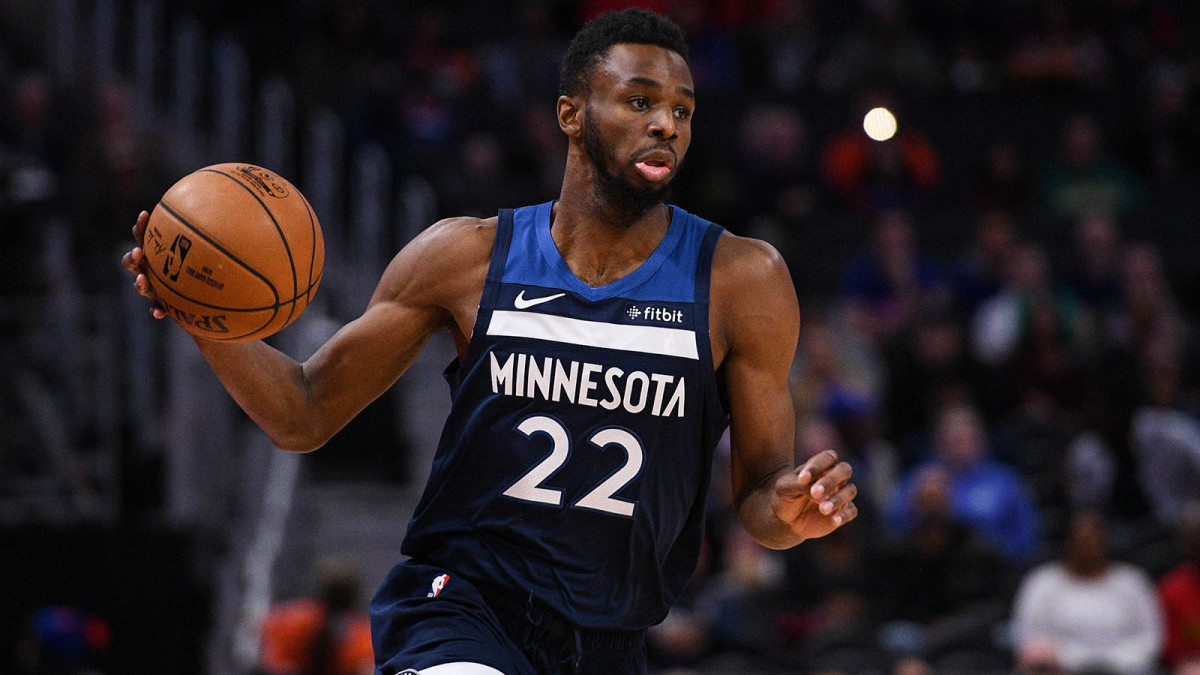Inside Andrew Wiggins's Revival in Minnesota


Ryan Saunders can’t remember the game. First week of the season, he thinks. The play, though—that sticks with him. Andrew Wiggins, ball in his hands, 18-feet from the basket. For years, the end result of that scenario would have been a mid-range jump shot, and given Wiggins history—type “Andrew Wiggins” and “inefficient” into a search engine and get ready to fall down a rabbit hole of web posts loaded with ugly statistics—it likely would have missed.
Only Wiggins didn’t shoot. He took two dribbles back, the tips of his sneakers floating behind the three-point line, and fired up a shot. Swish. Saunders, Minnesota’s first-year head coach, looked back at his assistants, incredulous. “We just hadn’t seen that before,” Saunders told SI.com. “Situations like that, flow of the game, sometimes you go back to what you’re comfortable with. He didn’t.”
Gersson Rosas doesn’t remember a play. He remembers a bunch of them. The hard runs to the corner. The activity on defense. The pivots off pick-and-rolls, when Wiggins steps into empty space and, instead of firing up a mid-range jump shot, Wiggins took a few extra dribbles and attacked the rim. “You can see him mentally and physically make the adjustment of, ‘No, I'm not going to settle. I'm going to get all the way to the rim,’” Rosas told SI.com. “You can see his commitment to doing what we asked him to do.”
Last summer, the ‘Wolves tabbed Rosas, a Rockets exec, to become the new team president. For 12 years in Houston, Rosas worked under Daryl Morey, an analytics-savvy GM. Wiggins is not an analytics-friendly player. But Rosas was also a teacher, with experience coaching at the high school and college level. And in Wiggins, he had a player seemingly teeming with untapped potential. “I’m a player development guy at heart,” Rosas said. “I love these kind of projects.”
Wiggins is one. With the NBA closing in on the quarter point of the season, Wiggins has been one of its biggest surprises. The sixth-year swingman is averaging 25.2 points, a career-high. He’s connecting on 46.9% of his shots—also a career high. He’s firing up 6.7 three’s per game, easily a career high. The Timberwolves, a 36-win Kardashian episode last season, are 9-8, functional and with the look of a playoff contender.
Entering the season, Wiggins was Minnesota’s wild card.
He still is.

For two years, the words seemed synonymous. Andrew Wiggins. $147 million contract. Andrew Wiggins, the Minnesota swingman with the $147 million contract, missed all 12 of his shots in a loss to Chicago. Wiggins, who will make $147 million over the next five years, connected on just 20% of his attempts against San Antonio. The words might as well have been stitched to the back of his jersey.
In Wiggins, Rosas saw a distressed asset. Rosas remembers Wiggins, circa 2013, an electrifying athlete who stood out in back-to-back Nike Hoop Summits. He remembers the smooth swingman at Kansas, a 6’8” torpedo in transition who could finish over anyone at the rim. “Ever since then,” says Rosas, “it's been peaks and valleys, a lot of ups and downs.”
Rosas knew Wiggins weaknesses—everyone did. When he was hired, he zeroed in on the positives. Wiggins age was one. Patience needs to be exercised with young players. Rosas had a birds-eye view of James Harden’s development from skilled sixth man into one of the NBA’s all-time great scorers. Six seasons in, Wiggins is still just 24. He’s experienced a lot, cycling through four coaches, surviving the Jimmy Butler experience and carrying the weight of No. 1 pick potential. That wasn’t lost on Rosas. “The reality is that he's been with multiple coaches and multiple offensive systems and multiple structures that have been stop and start for him,” Rosas said. “He's had some success, he's had some failure. But at the end of the day you see a guy who for how we wanted to play I couldn't find a better wing.”
In May, Rosas formally hired Saunders, the ‘Wolves interim coach for 42 games last season. For both, Wiggins was a priority. Saunders and Wiggins have been together since Wiggins was a rookie and Saunders was a young assistant on his father, Flip’s staff. Saunders was assigned to Wiggins. The two, along with Zach LaVine, worked out daily. They spent hours together in the film room. Ate meals on the road. A friendship was forged. Before Flip passed away, in 2015, Wiggins would make appearances at family dinners. When Saunders married in 2017, Wiggins was there. When Wiggins found out he was expecting a child with his girlfriend, former Notre Dame basketball player Mychal Johnson, he told Saunders. When Saunders learned his wife was expecting, he told Wiggins.
“I went through a lot earlier in my career and everything, he was there to listen to me and help me out,” Wiggins told SI.com. “To give me advice. So he got my trust and respect early.”
Together, Rosas and Saunders had one question: Did Wiggins want to be there? Rosas remembers the answer, vividly. “He said, ‘Hey, I don't want to go anywhere. I want to be successful here. I want the organization to be successful and I want to do everything within my power to make that happen,’” Rosas said. “I took him at his word.”
Wiggins wasn’t a broken player. He needed stability, which the Rosas/Saunders regime offered. And he needed to be tweaked. Shot selection came first. Wiggins fondness for the midrange game dated back to Kansas, but NBA coaches have little use for it. Saunders, like many, believes in three types of shots: Three’s, layups and free throws. Wiggins needed to shoot more three’s, look for more layups which, hopefully, would lead to more free throws.
Wiggins bought in. He spent more time in Minnesota this summer than in any previous offseason, Saunders says. He was a regular at the Timberwolves facility. Staffers recall Wiggins walking around the gym, mumbling: Gotta get better.
The lines of communications were open. There were conversations. “Hard conversations,” says Rosas. Rosas reminded Wiggins of the player he saw in high school, a defensive terror who sprinted out in transition. Saunders challenged Wiggins to rediscover his joy and passion for the game. It wasn’t a one-way street, either. Wiggins wanted answers, too. He wanted to know that the organization still believed in him. He wanted to know he would get opportunities. Opportunities, Rosas and Saunders said, would need to be earned.
In August, the team traveled to the Bahamas. They hit the beach. They sang karaoke. They celebrated rookie Naz Reid’s 20th birthday. At night, Wiggins, Rosas and Saunders dipped into a nearby jazz bar. They sipped wine. They listened to classic music. And they talked. Saunders told Wiggins how much he believed in him. Wiggins told them how he wants to be different. How he wants to learn from past mistakes. How he wants to live up to his potential.
“It was cool,” Wiggins said. “They picked my brain, I picked theirs.”
Saunders explained how his system would help him do that. Saunders didn’t change much after taking over for Tom Thibodeau last January. Didn’t think it would be fair to the players. But he had plenty of ideas. Three’s, of course, would never be discouraged. If Wiggins missed ten three’s one night, Saunders wants him to be comfortable shooting ten more the next. To Saunders, three’s represent not only a high value shot, but also an offensive rebound opportunity. Minnesota would play faster, maximizing Wiggins athleticism. Karl-Anthony Towns, Minnesota’s All-NBA forward, would spend more time on the perimeter, creating more space for Wiggins to operate. Robert Covington would be a small ball power forward.
The results weren’t immediate. Wiggins struggled in the preseason. He made 33.3% of his shots. He connected on 31.6% of his three’s. Most teams bring players in for exit interviews after the season. Rosas held them with each player after the preseason. Wiggins sat with Saunders and Rosas. They crunched the numbers. They told him they loved how hard he was working. But they could see him fighting the new system. They could see him get down when the shots didn’t fall. Stick with it, they told Wiggins. It will come.
And it has. The traditional numbers have improved. Rosas cites Wiggins assist ratio, which is a career-high. His shot block ratio is, too. With the ball in his hands more, Wiggins is averaging less than two turnovers per game. As his usage rate has gone up, so too has his efficiency. After shooting 21.7% from three in October, Wiggins is up to 38% in November. The effort numbers, says Rosas, have spiked.
On Monday, there was more. For weeks, the ‘Wolves had noticed a trend: When Wiggins was on the floor as the primary playmaker, the offense thrived. Saunders loves the ball in Wiggins hands. The pick-and-roll with Towns is effective. The ball moves across court better. Against Atlanta, Saunders pulled Jeff Teague from the starting lineup—and made Wiggins his starting point guard. Wiggins responded with 25 points, connecting on 50% of his three’s. He made the most of an opportunity. And he will get many more.
Hours before playing on Monday, Wiggins stretched out in a baseline seat at State Farm Arena. He’s getting used to the new media attention. He’s getting familiar with the questions, too. He dismisses the idea that criticism of his contract bothered him. “They pay me what they pay me,” Wiggins shrugged. He admits the revolving door of coaches hasn’t helped. “It’s been tough,” Wiggins said. “But nothing in the NBA is easy.”
The challenge this season, Wiggins said, is mostly mental. He’s constantly reminding himself to take better shots. Three’s if they are available. Hard drives to the basket if they are not. In Minnesota, there are stickers all over the ‘Wolves practice floor. On the stickers are numbers representing the expected point value of each shot. Just outside the three-point line: 1.3. Inside the line: 0.9.
“I feel like it helps me,” Wiggins said. “Just eliminate the [bad] shots.”
The improvement is there. Wiggins sees it, feels it. But he knows there is more. He thinks he can rebound more. He thinks his assist numbers should go up. He’s frustrated by games the Timberwolves have given away. “I feel like we left a lot of games on the table that we should have won,” Wiggins said. “That’s the most important thing, winning games.”
Minnesota wants to win. But Rosas is playing the long game. He’s revamping the organization. He’s fleshed out the front office with analytics-driven personnel. He’s added to everything from the sports performance team to the nutrition program. He wants to foster a family friendly environment. He sees the ‘Wolves as a startup, a team he needs to be patient with. The NBA has reverted to a two-star league. Minnesota has one in Towns. They hope Wiggins becomes another.
“Anytime you have better play, more efficient play as you grow your usage, that's something that's pretty interesting,” Rosas said. “That's him doing the work, the system helping him out and everything trending in a very, very positive way. It's a commitment to competing, working and buying into what's we’re doing that’s going to work for him. It’s going to work for our team.”
